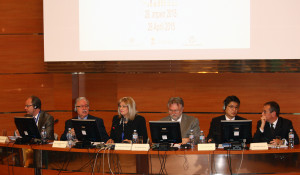Serbia
Key Documents
NPL Resolution Strategy, Executive Summary and Action Plan
- NPL Resolution Strategy - Executive Summary
- NPL Resolution Strategy
- Action Plan for the Implementation of the NPL Resolution Strategy
- Report of the Working Group for the NPL Resolution Strategy
National Bank of Serbia, in accordance with the NPL Resolution Strategy, adopted the Action Plan for the Implementation of the NPL Resolution Strategy.
For more information please see the link:
http://www.nbs.rs/internet/english/55/npl/action_plan.pdf
http://www.nbs.rs/internet/latinica/55/npl/akcioni_plan.pdf
(Documents courtesy of the Ministry of Finance Republic of Serbia)
Country-specific meetings
Belgrade Initiative - Resolution of Non-Performing Loans in Serbia
Belgrade, 28 April 2015
(Press release courtesy of the National Bank of Serbia)
On 28 and 29 April, the NBS hosted a two-day conference “Belgrade Initiative – Resolution of Non-Performing Loans in Serbia”. The conference was organised in cooperation with the Ministry of Finance and World Bank Financial Services Advisory Centre (FinSAC), and gathered a number of representatives of the private and public sectors and international financial institutions.
The conference was opened by NBS Governor Jorgovanka Tabaković, Finance Minister Dušan Vujović, Fernando Montes-Negret from the World Bank/FinSAC, Daehaeng Kim from the IMF, Matteo Patrone from the EBRD and Thomas Lubeck from the IFC.
Around 150 representatives of competent ministries, banks, international financial institutions, Association of Serbian Banks, domestic and foreign audit firms, investors and lawyers took part. In the first day, the focus was placed on solutions that have proven feasible and applicable to the NPL resolution in economic environments similar to Serbia’s. Participants agreed that the NPL resolution is a burning issue and that activities to be taken by public sector representatives must be coordinated. Namely, any isolated solution would not ensure comprehensive and long-term NPL resolution. One of the key messages is that coordinated action of all competent institutions is crucial.
Furthermore, participants underscored that macroeconomic and fiscal consolidation, whose effects are already palpable, will contribute to faster NPL resolution. Aware that resolving this issue cannot be either fast or simple, participants agreed that efforts must be directed at solutions applicable to all cases. Therefore, a thorough analysis of root causes and identification of all obstacles and bottlenecks is essential so as to preclude any fallout. Besides, the NPL resolution must be practicable and economically sustainable.
It was concluded that the NPL resolution must be financed by the private sector, whereas the public sector must provide support through regulatory incentives. Private sector representatives confirmed that numerous regulatory solutions have already been adopted but have not been implemented, which is why they need to be promoted.
Public and private sector representatives agreed that diagnostic studies of banks, carried out by the NBS in cooperation with the IMF, and following the methodology comparable with that of the ECB, will help better identify issues relating to NPLs. Moreover, developing the NPL market is one of the priorities, with foreign investors already showing interest. Everyone agreed that, in addition to finding solutions, their efficient implementation is of paramount importance.
The second conference day gathered a smaller circle of participants and was devoted to the dialogue between representatives of the public sector and international financial institutions. Emphasis was placed on the activities initiated or soon to be initiated in the field of resolving NPLs and preventing further build-ups. Also discussed were diagnostic studies of Serbian banks, enhancement of residential real estate appraisal, development of the secondary NPL market and successful corporate restructuring cases. It was reiterated that the NPL resolution should result only from coordination of all stakeholders, which is why a comprehensive NPL resolution strategy will be drawn up.
Presentations:
